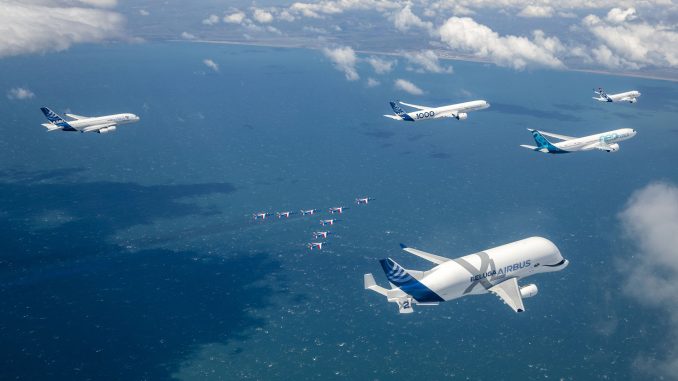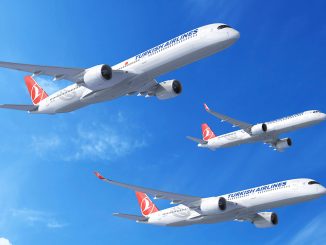
On 29th May 1969, the French and then West German governments signed an agreement to collaboratively build a new airliner. This moment marked the birth of the world’s first wide-body twin engine airliner. Called the Airbus A300, half a century later, it would become a concept that would become the single most popular format for large airliners around the world. On the 50th anniversary of that day, the European Aerospace giant is celebrating its 50th birthday.
Airbus marked the event with a flypast of its current line up, comprised of the A220 (formerly known as the Bombardier CSeries), A319neo, A330neo, A350-1000, A380 and the Beluga XL. A photo op took place where the Airbus fleet was joined by the Patrouille de France – the aerobatic display team of the French Air Force.
What a tribute, not only to our company but also to all our employees and aviation enthusiasts around the world. I'm very much looking forward to discovering more footage! Well done to all the @airbus and @PAFofficiel teams involved in this amazing kick off of our #Airbus50! pic.twitter.com/CM7Re9S9dO
— Guillaume Faury (@GuillaumeFaury) May 29, 2019
Over the years, the company has become one of the two dominant forces in commercial aviation, forming a duopoly with US plane-maker Boeing. The two giants of the industry have been fierce competitors since the introduction of the A300 in 1971. Boeing even congratulated Airbus upon reaching this significant milestone by producing a video addressed directly to its biggest rival.
From our team to yours, @Airbus, happy 50th anniversary. pic.twitter.com/Gbnj1m5H95
— The Boeing Company (@Boeing) May 29, 2019
Airbus has merged with and purchased many other aerospace companies since its conception, including the lineage of manufacturers such as Messerschmitt, Junkers, Dornier, Bölkow, Sud Aviation/Aérospatiale, Jagdflugzeug GmbH (partner of the Eurofighter Typhoon project) and Eurocopter (to form Airbus Helicopters) to name but a few. Today, Airbus is built up of a multinational consortium with bases in France, Germany, the UK and Spain.
To put a sense of perspective on Airbus’ place in the marketplace and the significance of its half centenary, it is crucial to look at its most important product. In 1987, Airbus introduced its third model with the A320. The company’s first single aisle short/medium haul airliner would directly compete against the most successful airliner in history: the Boeing 737. The A320 was also the first commercial airliner to feature a fully computerised ‘fly-by-wire’ flight control system, a technology previously found exclusively in fighter jets.
The A320 has become the backbone of the Airbus family offering in the same way that the 737 is for Boeing. The A320 is set to steal the crown from the 737 as the most successful commercial aircraft of all time; the A320 (including A320neo family) has an order book comprised of 14,639 combined historical and unfulfilled orders compared to Boeing’s 14,444 for the 737 family (which includes the 737 MAX). This is no mean feat considering the 737 had a 20 year head start over the A320.
In 2005, Airbus introduced the worlds largest airliner, the A380 ‘super jumbo’. Designed to compete with The Boeing 747, the A380 has pioneered many more engineering feats which will trickle down the Airbus family product line for decades to come. While orders for the A380 have dried up, there’s some irony that the latest Airbus flagship, the A350, is based on the same twin-engine wide-body format as the A300 which launched the company 50 years ago.
Matt is a Berlin-based writer and reporter for International Flight Network. Originally from London, he has been involved in aviation from a very young age and has a particular focus on aircraft safety, accidents and technical details.



